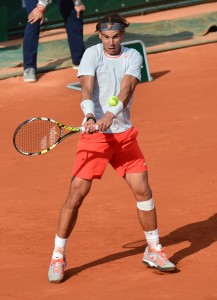 Coming off a record-setting eighth French Open title last month, 27-year-old Rafael Nadal was poised to make a run at Wimbledon and earn his 13th Grand Slam title overall. Instead, Nadal found himself on the wrong side of history in Monday’s first round at the All England Lawn Tennis Club when he fell to the No. 135 player on the ATP World Tour, Steve Darcis, in one of the greatest upsets in Wimbledon history.
Coming off a record-setting eighth French Open title last month, 27-year-old Rafael Nadal was poised to make a run at Wimbledon and earn his 13th Grand Slam title overall. Instead, Nadal found himself on the wrong side of history in Monday’s first round at the All England Lawn Tennis Club when he fell to the No. 135 player on the ATP World Tour, Steve Darcis, in one of the greatest upsets in Wimbledon history.
The Belgian Darcis stunned the Spaniard Nadal in straight sets, 7-6 (7-4), 7-6 (10-8), 6-4. The loss was Nadal’s first ever in the first round of a Grand Slam in 35 appearances, and it was one round earlier than his previous worst Grand Slam finish, which came at Wimbledon last year when he lost in a five-set thriller to Czech journeyman Lukas Rosol.
After dropping the match to Rosol last year, Nadal missed the rest of the ATP season with a nagging knee injury, an injury that clearly hindered his performance throughout the match. Monday’s first-round loss resurfaced the speculation that Nadal was playing through lingering knee issues.
Speaking with reporters after the match, Nadal did not say outright that his knee was troubling him during the three-set loss. However, he did not deny the injury when he said, “Everything that I will say today about my knee is an excuse, and I don’t like to put any excuse when I’m losing a match like I lost today.”
With the win, Darcis moved on to the second round of Wimbledon for only the second time in his career while becoming the lowest-ranked player to beat Nadal since 2006. He was supposed to play Lukasz Kubot from Poland in the second round, but an injury forced Darcis to withdraw from the tournament before the match. Kubot ousted Igor Andreev in straight sets in the opening round and now moves onto the third round after Darcis’ withdrawal.
When Darcis spoke with BBC Sports after the match, he made clear that targeting Nadal’s knee was not part of his strategy against the player ranked No. 5 in the world.
“I just wanted to play my own game, coming to the net and not playing far from the baseline,” the 29-year-old Darcis said. “I did not target his knee; tennis is hard enough when you are thinking about yourself.”
Entering his Monday match with Nadal, Darcis was the owner of a 71-80 career record with two titles on the ATP World Tour. With the loss and potentially injured knee, the rest of Nadal’s season and career become increasingly more complicated to predict.
Nadal’s knee issues are exacerbated on surfaces other than clay, the surface on which Nadal learned to play the game in his hometown of Mallorca, Spain, under the watchful eye of his coach and uncle, Toni. The quick and aggressive stops on hard court wear down a player’s joints, which is the polar opposite of the graceful sliding stops that clay surfaces afford a player.
Nadal has won the French Open on the clay court in eight of the past nine years, the record for most Grand Slams at a single event, earning himself the nickname “the King of Clay.” He has only won the other three Grand Slams a total of four times, and none since he won the U.S. Open in 2010.
The U.S. Open on the hard court in Queens, N.Y. is the ATP’s last Grand Slam of the year, which begins Aug. 26. Even the four warm-up events prior to the U.S. Open are played on hard court, giving Nadal a tough preparation decision. Does he warm up with a hard-court event prior to the U.S. Open, or does he save his knees for the season’s final Grand Slam?
One player who was breathing a major sigh of relief after Nadal’s stunning Wimbledon loss was No. 3 Roger Federer. Federer, the Swiss who was going for his record eighth career Wimbledon title, was the top-ranked player in Nadal’s quarter of the draw before he was upset by the Ukrainian ranked No. 116, Sergiy Stakhovsky. Without Nadal, No. 11 Stanislas Wawrinka and No. 18 John Isner, who were also upset, Federer’s path to the semifinals had become much less challenging. Now, Nicolas Almagro, the Spaniard ranked No. 15 in the world, is the highest-ranked player left in Federer’s quarter.
The winner of Federer’s quarter will meet the winner of No. 2 Andy Murray’s quarter of the draw semifinals. Murray’s draw had included Jo-Wilfried Tsonga and Marin Cilic — two top-10 players on the verge of breakout performances — before Tsonga fell in a second-round upset and Cilic was forced to withdraw due to a knee injury. Murray, the 26-year-old Brit, now has a great chance of returning to the Wimbledon final for the second year in a row.
Even if he could have brought home another title on the grass at Wimbledon, Federer is undoubtedly on the downside of his career. The 31-year-old is no longer the dominant force that he once was in his twenties.
Nadal knows all about the career decline. Even though he turned 27 June 3, his knees probably feel like they just turned 37, and the injuries have plagued the left-hander’s energetic style. Monday’s straight-set loss to Darcis was just one more example that the “King of Clay” is simply not king anywhere else.

